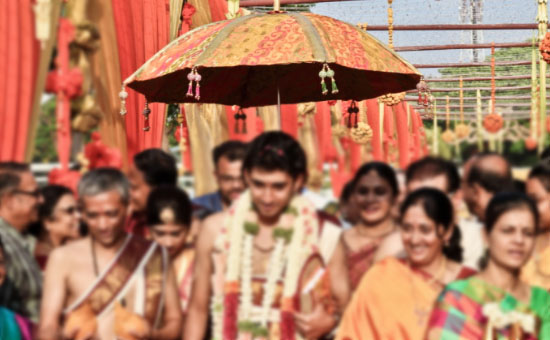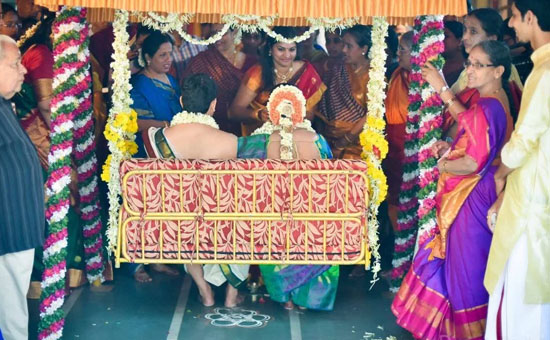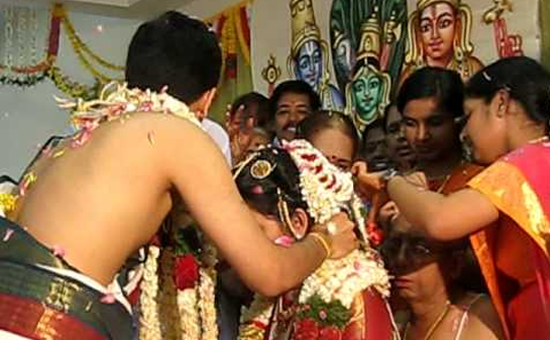"Seetha kalyana vaibhogame
Rama kalyana vaibhogame"
Iyer weddings are never complete without the rendition of this beautiful Thyagaraaja composition, which celebrates the grandeur of the wedding of Sita and Rama. This song is symbolic of the bride and bridegroom being embodiments of Sita and Rama – a celebration of the celestial amidst the human.
Marriages in the Hindu tradition, through different customs, rituals and ‘mantras’ chanted from the Vedas, seek to invoke and cherish the divine in mortal humans. These ceremonies not only bind individuals and families but also have a purifying effect on the body and soul and are essential aspects of the preparation required to embark on a new phase of life filled with its own myriad challenges and goals. It is said that of all the four ‘Ashramas’, namely, ‘Brahmacharyashrama’, ‘Grihasthashrama’, ‘Vanaprasthashrama’ and ‘Sanyasashrama’, ‘Grihasthashrama’ is superior as, ideally, it is a householder who provides for and supports all the other ‘Ashramas’. Marriage, which marks the stepping into ‘Grihasthashrama’, is one of the most important ‘samskaras’ among the 16 ‘samskaras’, which an individual has to undergo right from conception in the womb of the mother until death.
A traditional Iyer wedding is a beautiful amalgamation of ‘Vaidika’ ceremonies (rituals as per Vedic scriptures) and various other rituals that offer the perfect platform for families to bond and rejoice on the happy occasion. While the core marriage rituals are Vedic, these are accompanied by a lot of other rituals that are ‘loukika’ in nature – not prescribed in the Vedas or the Puranas but are in practice due to popular acceptance over a period of time. These ‘loukika’ rituals may not be uniformly followed by all Iyers. Customs and practices followed by individual families may be different.
Nevertheless,
there are a few common pre-wedding and wedding rituals that are a hallmark of
every wedding in the community. Let us take a peek at these colourful
ceremonies that are ensconced in the realms of the sacred and give a sense of
unison between the material and the spiritual.
Pre-wedding
rituals
‘Nischyadaartham’: In case of most Iyer weddings, matching of the horoscopes of the boy and the girl is an important step. Once the marriage is fixed, the ‘nischayadaartham’ ceremony (engagement ceremony) is held on an auspicious day. Following a pooja invoking the blessings of Lord Ganesha to remove all obstacles, an exchange of ‘nalikera’ (coconut) and ‘thamboola’ (betel leaves and areca nuts) is done in the presence of elderly members of both families. This ritual is also known as ‘vaang nischaya’ (giving commitment by word). The reading of the ‘lagna patrika’ giving details about the date, day, time (muhurtham) and place of the wedding along with family details of the bride and the groom, which is then signed by representatives of both the families, is a later addition to the ‘nischyadaartham’ and has now become a part of this ceremony, over a period of time.
‘Sumangali prarthanai’: This is a prayer done by the married women invoking the blessings of female ancestors, who would have passed away as ‘sumangalis’ (died before their husbands). ‘Sumangalis’, who are invited from among known circles, are supposed to represent the ancestral ‘sumangalis’ and are worshipped and fed as per the customs and practices prevalent in individual families. Along with the ‘sumangalis’, a ‘kanya’ is also worshipped and partakes of this feast. Usually, the ‘sumangali prarthanai’ in the bride’s family is done before the wedding so that the daughter, who will be getting married, can be a part of the ceremony and receive blessings. In case of the groom, it is done immediately after the wedding so that the new daughter-in-law can participate as a ‘sumangali’ in this ritual.
‘Pongi podal’: The bride and the groom are invited by their respective aunts, i.e., mother’s brothers’ wives (‘maamis’) and father’s sisters (‘athais’) and treated to a traditional feast including ‘pongal’ (made of rice, lentils and turmeric) and some other dishes that they might like to have. This feast is prepared by elders of the family to celebrate and bless the bride and the groom, who will then go on to form a family of their own.
‘Yatra daanam’: The groom and his family travel to the bride’s place of residence (or the venue of the wedding) after praying to Lord Ganesha and giving ‘daana’ to Brahmins to ward off evils. It is also considered auspicious to break a coconut before commencing the trip.
A typical Iyer wedding in earlier times was generally celebrated over a period of four days. Nowadays, it is customary to have a two-day wedding schedule. Prior to these two-days, smaller ceremonies are held at the bride’s and the groom’s residences respectively, which involves praying to ‘kula-devatas’ (family deities), erecting a ‘panda kaal’ or bamboo pole with plantain covered decoration outside their homes after special prayers for the smooth conduct of the wedding and applying mehendi for the bride and other ladies of both the families (the groom also has to apply some mehendi symbolically). Traditional songs are sung, while family members joyously come together to prepare for the subsequent wedding ceremonies.
These days, though, elaborate ‘mehendi’ and ‘sangeet’ ceremonies are part of many Iyer weddings including curated performances on popular Bollywood and regional movie songs. Since most of the wedding preparations are now taken care of by event managers and caterers, families today are a bit more relieved and have some additional time to let their hair down and enjoy the festivities.
Key rituals that
are done on the first day of the two-day wedding ceremonies include:
Receiving the groom’s party: In country-side weddings in the olden times, the groom’s party used to be welcomed at the boundary of the bride’s village with the ‘nadaswaram’ being played. Nowadays, the groom’s party is ceremonially received at the entrance of the wedding venue by the bride’s parents and relatives. They are received with coconuts, flowers and thamboola with two decorated conical structures called ‘paruppu thengai kutti’ (traditionally made out of jaggery, lentils and coconut).
‘Vratham’: This Vedic ritual involves the groom taking permission from his father (Guru) to end his ‘Brahmacharya Vratha’ and get married to lead the life of a ‘Grihastha’. Both the bride and the groom are made to perform certain ‘samskaras’ and a sacred string of protection called 'Kaapu' or ‘raksha’ is tied to the wrists of the bride and the groom after chanting of Vedic mantras to protect them from all evil spirits.
Sprinkling of ‘paligai’: This ritual originally involved planting a row of trees by the families of the bride and the groom. Over a period of time actual planting of trees has given way to germinated seeds of nine kinds of pre-soaked grains being sowed in five clay-pots each for the bride and the groom’s side. These seeds are sowed into these clay-pots along with the sprinkling of milk mixed with water by married women from both families with prayers for a long and happy married life for the couple and blessings for their progeny.
‘Januvasam’: As part of this function, the groom is brought to the ‘mantapam’ in a grand procession accompanied by ‘nadaswaram’ and sometimes bursting of crackers. The rituals done during the ‘nischyadaartham’ are repeated here and the bride’s brother presents clothes and jewellery to the groom and the groom’s sister does likewise to the bride. Both are then taken to a nearby temple to obtain blessings.
 Kasi Yatrai
Kasi Yatrai
Important
rituals on the day of the wedding are:
‘Kasi yatrai’: In this ritual, the groom carries a bamboo fan, an umbrella, a walking stick and a ‘grantha’ (like the Bhagavad Gita), wears new slippers and sets
out to go to Kashi (Varanasi) for further learning. He is stopped by the bride’s father who requests him to stop travelling for learning and offers to give his daughter in marriage to him so that he can return to be a ‘Grihastha’. The groom agrees and returns to the ‘mantapam’ for further rituals.
 Oonjal
Oonjal
‘Maalai matral and oonjal’: The bride arrives at the ‘mandapam’ and then, garlands are exchanged by the bride and the groom amid cheering by family members. Subsequently, the groom leads the bride by holding her hand to a decorated ‘oonjal’ or swing. While they are seated on the swing, married ladies from both families symbolically wash the couple’s feet with milk by sprinkling some milk on their feet and wiping that with the edge of their sarees. The women then wave coloured rice balls around them and throw these balls in all directions to ward off evil. The bride and the groom are given a mixture of milk with pieces of bananas. Women of both families sing songs for this occasion.
This is followed by the ‘vara poojai’ wherein the bride’s father welcomes the groom and washes his feet with water and the groom begins the marriage rituals with a prayer to Lord Ganesha.
Telling of the ‘Pravaarams’: The ‘Gothras’ of both the bride and the groom are announced loudly by the priest along with their lineage up to three generations (father-grandfather-great grandfather).
‘Kanya daanam’: The bride sits on the lap of her father, who holds a ‘thamboola’ (betel leaves and areca nut) in his palms. She then places her palms holding a coconut on her father’s palms. As the groom receives the bride’s hand from her father, the bride’s mother pours water over her daughter’s hand, which is made to fall on the ground like a ‘dhaara’. This ceremony is called ‘dhaarai
vaarthu kodukkal’ in Tamil. The mantras chanted by the bride’s father symbolise the groom as a personification of Lord Vishnu. The ‘Gothra’ of the bride is changed to that of the groom.
The groom then gives the ‘koorai podavai’ – a traditional red coloured nine-yard saree to the bride (the ‘koorai podavai’ is not necessarily only red in colour and can be of other colours as well). The groom’s sister and other ladies of his family take the bride away to help her drape the ‘koorai podavai’ for the ‘maanglya dhaaranam’. The bride’s father then, once again, washes the feet of the groom and gives him a mixture of curd, honey and ghee.
 MAANGALYA DHAARANAM
MAANGALYA DHAARANAM
‘Maangalya dhaaranam’: The bride returns draped in the ‘koorai podavai’ and sits on her father’s lap once again. The ‘maangalya’ or ‘mangala sutra’ refers to twin pieces of gold (one given by her father and one by the groom’s family) shaped as per the family custom of the groom and arranged on a yellow-coloured string and tied around the bride’s neck in three knots. The groom ties the first knot of the ‘maangalya’ around the neck of the bride amid chanting of mantras, while his sister ties the remaining two knots. Tying of the ‘maangalya’ is done amid a crescendo of the ‘nadaswaram’ and ‘ketti melam’ and showering of ‘akshadhai’ (rice smeared in turmeric) and flower petals by family members and friends, who bless the couple.
The groom, then, ties a rope made of ‘darbha’ grass around the bride’s hip praying for her to be blessed with good health, children, wealth and prosperity. He further leads the bride holding her right hand and sits in front of ‘Agni’ (holy fire). The groom’s sister, usually, adorns the bride with silver toe-rings (‘metti’ in Tamil).
‘Sapta-padhi’: ‘Sapta-padhi’ or seven steps is vital for the completion of the marriage. The groom takes the right foot of the bride and makes her take seven steps with prayers for her happiness, well-being and prosperity.
The bride and the groom then circle the ‘Agni’ and on reaching an ‘ammi kal’ (grinding stone) kept in Northern side of the fire, the groom takes the toe of the bride’s right leg and places it on the stone. When they return to sit in front of the fire, the bride’s brother puts two handfuls of puffed rice in her hands, which is then offered to the ‘Agni’ by the bride and groom with a small quantity of ghee. This entire ritual is repeated thrice.
Another interesting ritual is when the bride and groom are asked to take a look at the two-star constellation of ‘Arundhati’ and ‘Vasishtha’, which is part of the bigger ‘Saptarishi’ or ‘Big Dipper’ constellation. In this special constellation, the two stars, ‘Arundhati’ and ‘Vasishtha’ move in tandem while revolving around each other, just like how a married couple should be.
At the time of completion of chanting of mantras, the groom unties the ‘darbha’ rope tied around the bride. This is followed by blessings showered upon the newly-married couple by all the elders of both the families.
The first visit of the bride to the groom’s place and of the groom to the bride’s place is marked with female relatives giving them ‘paalum pazhamum’ or a mixture of milk with bananas. A ‘nalangu’ ritual may be held either at the wedding venue or at the groom’s residence, wherein the bride and the groom are made to play some fun games that are more of an ice-breaker between the bride and the groom and also between the bride and her new family.
These
rituals are usually followed by a grand reception for the bride and the groom
by family and friends. Carnatic music and dance performances (either by
professionals or family members) are also sometimes organized as part of the
celebrations.
While they are an eclectic mix of Vedic and ‘loukika’ traditions and are solemnized with the chanting of Vedic mantras, Iyer weddings are also a kaleidoscope of colours and a rhythmic mix of sounds. You cannot miss the swish of elegant Kanchipuram sarees of different hues, the jingle of traditional jewellery, the heady fragnance of jasmine flowers, the changing octaves of the ‘nadaswaram’ and ‘ketti melam’ at different points of time during the wedding rituals and the whiff of a grand, sumptuous feast served on banana leaves. Guests are normally bid farewell with a bag of goodies – sweets and savouries – and coconuts with ‘thamboola’ (betel leaves and areca nuts).
References:
1. Rituals in Hindu Marriages
2. Brahmin Rituals
Also read
1. Marwari Wedding Rituals
2. Nair Wedding Kerala
3. Ahom Assamese Wedding